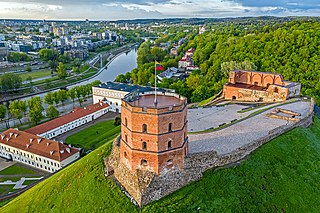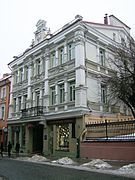
Vilnius is the capital and largest city of Lithuania. As of July 2023, Vilnius's estimated population was 593,436. The Vilnius urban area, extending beyond the city limits, had an estimated population of 718,507 in 2020. By November 2023, there were approximately 768,342 permanent residents in Vilnius city and Vilnius district municipalities combined.

Didžioji Street is a street in the Old Town of Vilnius, the capital of Lithuania. It currently connects Pilies Street and Aušros Vartų Street. The street surrounds the Vilnius Town Hall and in the past was visited by many well-known people including Francysk Skaryna, Mikołaj "the Black" Radziwiłł, Konstantinas Sirvydas, Joseph Frank, Christina Gerhardi-Frank, Jan Karol Chodkiewicz, Napoleon, Sophie de Choiseul-Gouffier, Fyodor Dostoevsky.

Vilnius University Hospital Santaros Klinikos in Vilnius, Lithuania is a teaching hospital of the Vilnius University Faculty of Medicine. Santaros Klinikos is co-funded by the Lithuanian Ministry of Health and Vilnius University. It has a staff of 5372 employees, including 1409 medical doctors, 1978 nurses and other highly qualified professionals. More than 370 professors and doctorates and 4 academics are providing assistance to the patients.
Stem Cell and Regenerative Medicine Cluster is a business cluster located in Vilnius, Lithuania. Founded in 2011 the cluster unifies 11 SMEs and state enterprises, including research centers, hospitals, medical centers, and other related institutions. The cluster is currently managed by the Stem Cell Research Center.

Vilnius University Astronomical Observatory is an astronomical observatory of Vilnius University. It was founded in 1753 by initiative of Thomas Zebrowski. The observatory is the fourth oldest observatory in the Europe. While the observatory is no longer able to make astronomical observations due to light pollution in Vilnius, it continues scientific research.

Didžioji Riešė is a village and administrative centre of Riešė eldership, Vilnius District Municipality, Lithuania. It is located only about 1 kilometre (0.62 mi) north-west of Vilnius city municipality, on the road Vilnius–Molėtai. At the 2011 census, the village had a population of 2,520. That was an increase from the 2001 census which recorded the population of 1,142.
The Lithuanian Education Society Rytas was a Roman Catholic society fostering education in the Lithuanian language mostly in the Vilnius Region, then fiercely contested between Lithuania and the Second Polish Republic, now split between Lithuanian and Belarus. Established in 1913, the society maintained some 100 primary schools, 50 evening classes, Vytautas the Great Gymnasium and Teacher's Seminary in Vilnius in 1927. Due to political tensions between Poland and Lithuania as well as wider Polonization policies, Rytas faced increasing difficulties and restrictions in maintaining its schools. Similar situation existed with Polish schools in Lithuania. The situation continued to worsen as both sides increased restrictions in retribution. As schools were closed, Rytas shifted its focus to maintaining community reading rooms. After the death of Józef Piłsudski in 1935, the rooms were often raided by police and closed. Eventually, the society was abolished by Polish authorities in February 1938. Only the Vytautas the Great Gymnasium was allowed to operate. After the Polish ultimatum of March 1938, diplomatic relations were established between Poland and Lithuania and Rytas was allowed to operate again in May 1939. It could not resume its activities due to World War II and was abolished again soon after the occupation of Lithuania by the Soviet Union in June 1940. The society, with the same mission of promoting Lithuanian-language education, was reestablished in 2004.

Petras Avižonis was a Lithuanian ophthalmologist, rector of the University of Lithuania (1925–1926) and a political figure.

The Józef Zawadzki printing shop was a family-owned printing shop operating in Vilnius from 1805 to 1939. It was established by Józef Zawadzki who took over the failing printing press of Vilnius University established in 1575. It was one of the largest and most prominent printing presses in Vilnius. Until 1828, it had the exclusive rights to publish university publications. It published numerous books and periodicals in Polish, Latin, Lithuanian. It suffered difficulties due to Russification policies that closed Vilnius University in 1832 and banned Lithuanian press in 1864, but recovered after the restrictions were lifted due to the Russian Revolution of 1905. After World War I, it had difficulty competing with the larger printing presses in Poland. The press was sold to a Lithuanian company Spindulys in 1939 and nationalized by the Lithuanian Soviet Socialist Republic in 1940. After World War II, the press was transferred to the communist daily Tiesa.
Draugija was a Lithuanian-language magazine published in Kaunas in 1907–1914, 1919–1923, and 1937–1940. Published by the Society of Saint Casimir, it focused on the issues of Lithuanian culture, literature, science, and politics and was geared towards the intelligentsia and the Catholic clergy. It urged everyone to work on developing the Lithuanian culture which would distinguish the Lithuanian nation from others and believed in slow and steady cultural work. The magazine critically reviewed essentially every more substantial work of Lithuanian literature, published articles to improve and standardize the Lithuanian language, discussed how to improve education, analyzed social and political issues in Lithuania, promoted Christian democracy, criticized ultra-conservatives and attempted to find the proper place for the Catholic Church in modern society and science. Its issues usually had more than 100 pages and reached circulation of 1,000 copies. Its long-term editor was Catholic priest Adomas Jakštas (1907–1938). In total, 213 issues were published. Its supplement for Catholic youth Ateitis (Future) edited by Pranas Dovydaitis gave rise to the Lithuanian Catholic Federation Ateitis.

Veronika Alseikienė née Janulaitytė (1883–1971) was a Lithuanian physician and activist.
Barbora Burbaitė-Eidukevičienė (1867–1939) was a Lithuanian physician. Graduating from the University of Zurich in 1892, she became the first Lithuanian woman to obtain a university degree.

The Lithuanian Sanitary Aid Society was a Lithuanian society established in 1918 to provide medical care to refugees during World War I. First established in Minsk, the society purchased hospital equipment of a war hospital and relocated to Vilnius in July 1918. There it opened a hospital and continued to operate it until around 1941. Over the years, the hospital treated a total of about 300,000 patients. It was a charitable society, thus many of its treatments were provided at low cost or for free. After Vilnius incorporation into the Second Polish Republic, the society and the hospital were one of a few Lithuanian institutions active in Vilnius Region. The society and the hospital were headed by Danielius Alseika and, after his death, by Vytautas Legeika.

Danielius Alseika (1881–1936) was a Lithuanian physician and activist. He was the father of the archaeologist Marija Gimbutas.
The Society of Saint Casimir for the Education and Care of Young People was a society of the Lithuanians living in Vilnius Region which was controlled by the Second Polish Republic but claimed by the interwar Lithuania. Established in 1925 to promote the Lithuanian national identity and Catholicism, the society organized chapters and reading rooms in various towns and villages and organized various cultural events, mostly amateur theater performances. It had chapters in 482 locations in total and about 20,000 members in 1935.
Vincentas Taškūnas (1880–1967) was a Lithuanian Roman Catholic priest.

Julija Biliūnienė née Janulaitytė (1880–1978) was a Lithuanian dentist.
Vilnius Vytautas Magnus Gymnasium is a gymnasium in Vilnius, Lithuania. Established in 1915, it became the first Lithuanian-language high school in the city. During the interwar period, the school was one of the key Lithuanian institutions in Vilnius Region which was incorporated into the Second Polish Republic and claimed by Lithuania. Many prominent Lithuanians worked and studied at the school.
The Lithuanian Historical Society was a society of Lithuanian historians established in 1929 in Kaunas. It was the first society dedicated to history in Lithuania and was a sign of historians becoming more professional. It sought to improve historical research and historical publications, but was not very active. It published only two volumes of its journal Praeitis. It ceased activities after the Soviet occupation in June 1940. The society was reestablished during the Glasnost reforms and was active in 1988–2001.

Andrius Domaševičius was a Lithuanian politician and gynecologist. He was one of the founders and an active member of the Social Democrat movement in Lithuania.















